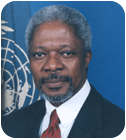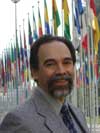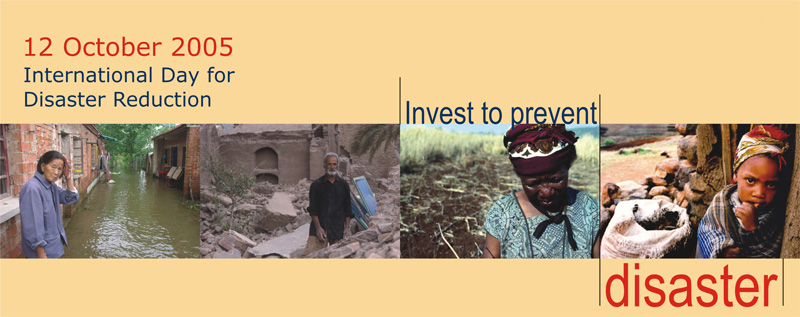On
the occasion of the International Day for Disaster
Reduction, to be held on 12 October 2005, and to mark
the International Year of Microcredit, the Secretariat
of the International Strategy for Disaster Reduction
(ISDR) is launching a global debate on how microfinance
can reduce the impact of natural disasters on vulnerable
communities.
The 2004 Indian Ocean tsunami and more recently Hurricane
Katrina in the United States and the earthquake in Pakistan
and India demonstrated once again that the poor usually
suffer most from disasters occuring from natural disasters,
as they often live and work in highly vulnerable locations.
Microcredit is a useful tool for poverty reduction, but
its potential to reduce the impact of disasters needs
to be further explored.
UN/ISDR
asked experts and colleagues from various backgrounds
to share their points of view on the issue. These
are summarised in 10
conclusions, and available in detail in the
document Invest
to Prevent Disaster .
There are many examples throughout the world of successful
disaster risk reduction through microfinance. Some case
studies can be found here, while expert
opinions and experiences are available here. A
case produced by the Kenyan
Red Cross will be presented by the IFRC at the
Geneva press briefing.
Many
organisations and institutions are involved in
microfinance for disaster reduction. A selection
of links can be found
here.
To celebrate the International Day for Disaster Reduction,
UN/ISDR and its partners are organising various events
around the world. A number of financial experts,
disaster managers and UN specialists will gather on
14 and 15 October in New Delhi, India, to discuss the
impacts of microfinance in countries affected by the
tsunami last December. Other events will also take
place in Geneva, Switzerland; Bangkok, Thailand; and
Dushanbe, Tajikistan to promote dialogue on the potential
of using microfinance tools to reduce disaster risk
and increase community resilience. ISDR will prepare
a publication on the results of the debate by the end
of the year for wide dissemination.
|
|
 |
THE
SECRETARY-GENERAL
MESSAGE ON THE INTERNATIONAL DAY FOR DISASTER REDUCTION
New York, 12 October 2005 |
|
PDF
format:
English - French - Spanish
Arabic - Chinese - Russian |
The
past year has reminded people everywhere that no
place in the world is immune from natural disaster.
From the massive Indian Ocean earthquake and tsunami
to the drought- and locust-ravaged countries of
Africa, from the devastation caused by hurricanes
and cyclones in the United States, the Caribbean
and the Pacific to heavy flooding across Europe
and Asia, hundreds of thousands of people have
lost their lives, and millions their livelihoods,
to natural disasters.
The
lesson we must draw is encapsulated in the theme
of this year’s International Day for Disaster
Reduction: “Invest to prevent disaster.” We
cannot stop natural calamities, but we can and
must better equip individuals and communities to
withstand them. Those most vulnerable to nature’s
wrath are usually the poorest, which means that
when we reduce poverty, we also reduce vulnerability.
In
this International Year of Microcredit, we should
recognize that microfinance can do much to help
empower those with little or no access to traditional
financial institutions, thereby reducing disaster
risk and improving disaster management. By diversifying
the income of high-risk populations and promoting
disaster insurance, microfinance can strengthen
coping mechanisms before disasters, while hastening
recovery afterwards.
These
are the type of innovative approaches called for
in the Hyogo Framework for Action 2005-2015, adopted
at the World Conference on Disaster Reduction in
January, and reaffirmed in September at the World
Summit at United Nations Headquarters in New York.
On this International Day, after a year in which
we should all have learned profound lessons, I
call on governments at all levels, international
organizations, civil society groups, and the private
sector to implement this framework and invest in
poverty reduction and disaster prevention, in order
to build resilient communities and save lives.
|
|
 |
|
Salvano
Briceño, director of the UN/ISDR secretariat
“Investing
in disaster risk reduction
reduces the vulnerability
of people to hazards and
helps break the vicious cycle
of poverty. We need to engage
the micro finance community
into a dialogue on reducing
the impact of natural hazards
on populations and livelihoods "
"Micro
finance is a successful tool to empower women
to help reduce their poverty and therefore, their
vulnerability to disasters.”
|
|
|
|
| Microfinance
is a tool that has successfully been utilized to improve
livelihood options and reduce poverty. It has hardly been
used yet as a tool for reducing risk vulnerability to natural
hazards. Leading up to the International Day for Disaster
reduction (12 October 2005), the ISDR secretariat will promote
dialogue with the microfinance community on the possibility
of using these tools to reduce disaster risk and increase
community resilience to disasters. |
 |
|
|
|
|
 |
|
|
 |
| Events |
Africa
Nigeria
Launch of the Nigeria National Platform for Disaster
Reduction
13-14 October, Abuja, Government of Nigeria
UN/ISDR Africa Outreach (ISDR-Africa@unep.org) |
|
|
Europe
Switzerland
Press Briefing, 11 October, Palais des Nations,
Room 3, 11.30 am
UN/ISDR Secretariat, Munich Re, Deutsche Bank,
Provention Consortium, IFRC
Brigitte Leoni (leonib@un.org) |
|
|
| See
more events |
|

